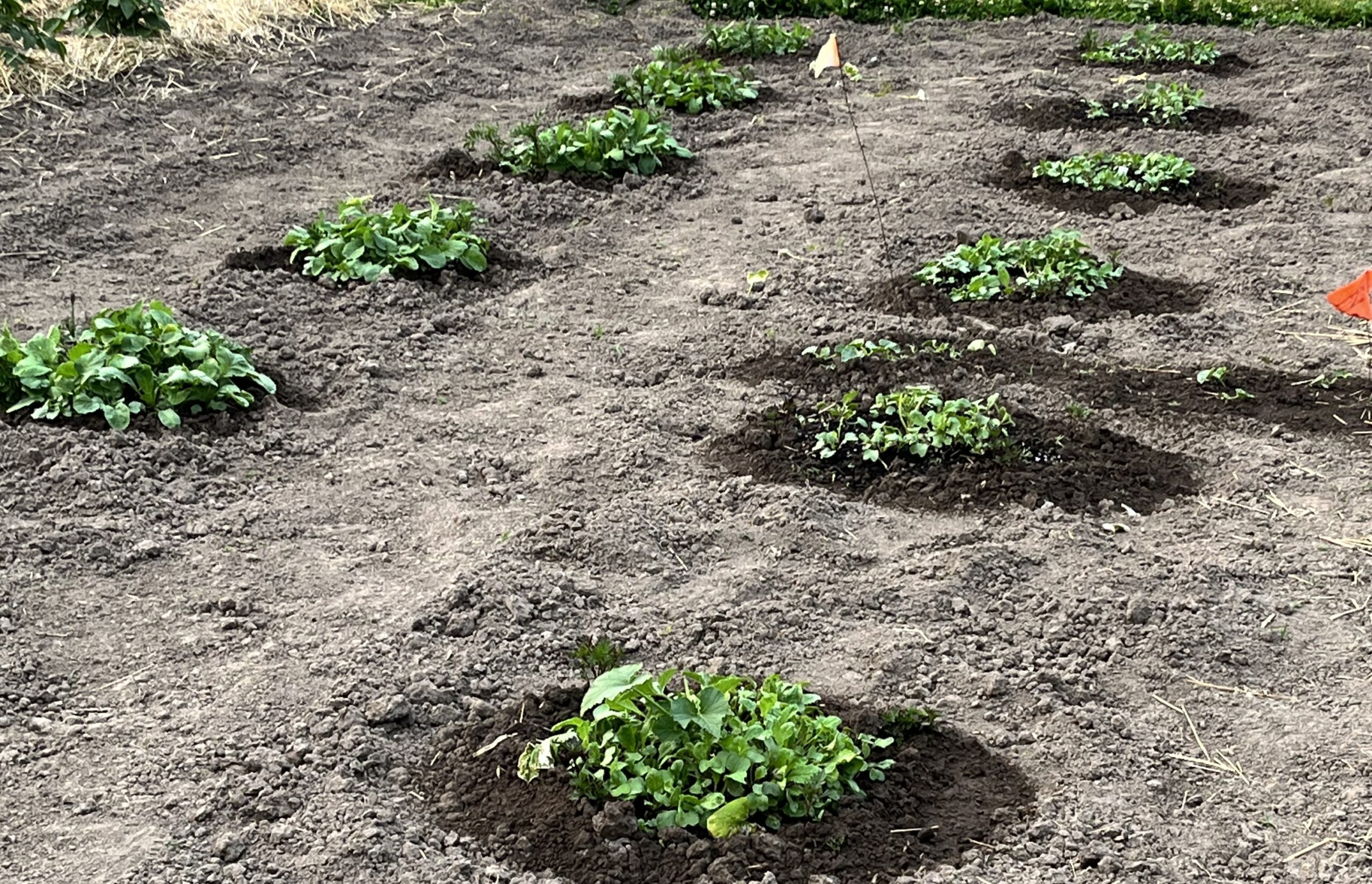The Hort Report: Fighting insects, weeds in garden can be done without chemicals, pesticides

You can do anything you want to do in your garden, flowerbed and yard during this time of year. You can harvest cool-season vegetables. Even some fruit is ready to harvest.
Working on the St. Mary Community Garden has been a learning experience in several ways, such as knowing what people like and don’t like and how much of everything to grow.
One of the biggest things we have learned is how to fight insects and weeds. We do this by not using any chemicals or pesticides. Some basic things can be done.
To fight weeds and grass, we use straw mulch around cucumbers, tomatoes, peppers and potatoes. This also allows them to conserve water. I have also used newspaper under the plants so no sunlight can get down to the soil, helping to keep the weeds from growing.
Tilling and hoeing between the rows and around all the plants in the ground is important. Hoeing the raised beds is easy. Once some of the vegetables get big enough in the garden soil, they begin to shade the soil, keeping the weeds from germinating and growing.
Stay on top of keeping weeds in check. If you can kill them in an early stage of growth, the easier it is. Check for weeds and kill them every time you work in the garden.
Fighting insects is sometimes harder than fighting weeds. Once insects get started on your vegetables, you have a dfficult time stopping them.
I like to plant plants that help repel insects. The hardest vegetables to keep insects from attacking are pumpkins, gourds and squash-type vegetables. Tomatoes have some insects that bother them, too.
What we do is to plant the repelling plants a few days before we plant the vegetables using transplants and seeds. This way they are up and growing before the vegetable plant is so they can repel the insects days before the vegetables are in the soil.
Plants I use to fight insects in vining vegetables are marigolds and radishes. They give off a scent that repels the most harmful insects that attack vining vegetables.
We plant marigolds about 18 inches from the center of where we plant the vining vegetables, then we plant the radishes about 12 inches in a circle around the middle of the location. We find that the radishes spread their leaves and start giving a scent within a couple of weeks.
Marigolds are used in several other places in the community garden, too. Using them around tomatoes has been helping keep small insects away from them.
Other plants that help repel insects are lemongrass, lemon thyme, lemon balm, lavender, garlic, rosemary, nasturtiums, mums, petunias, basil, mint and catnip.
I use all-natural spray and powder in fighting insects. I have used Neem Oil during the past year. It kills insects in all their forms of life. You spray it on the foliage and stem. As the insect feeds on the plant, they get it in their body. Within one or two days, they are starting to die. Neem Oil also affects the hormone system of insects, making it hard for them to reproduce.
I use Diatomaceous Earth, an organic insecticide powder. Put the powder on the leaves and stem of the plant. The insects are killed by their exoskeletons being damaged and absorbing the oil, causing dehydration and death.
When using Neem Oil and Diatomaceous Earth, you need to reapply after a rain or watering.
I appreciate all your questions in the past and look forward to them in the future. Thanks and please keep them coming. Call me 573-588-2040, visit me at Shelby County Implement in Shelbina, Mo., email me at sci63468@hotmail.com, check out Greenwell’s Greenhouse Group on Facebook or ask me anytime you see me.
Enjoy the warm weather.
You can do anything you want to do in your garden, flowerbed and yard during this time of year. You can harvest cool-season vegetables. Even some fruit is ready to harvest.
Working on the St. Mary Community Garden has been a learning experience in several ways, such as knowing what people like and don’t like and how much of everything to grow.
One of the biggest things we have learned is how to fight insects and weeds. We do this by not using any chemicals or pesticides. Some basic things can be done.
To fight weeds and grass, we use straw mulch around cucumbers, tomatoes, peppers and potatoes. This also allows them to conserve water. I have also used newspaper under the plants so no sunlight can get down to the soil, helping to keep the weeds from growing.
Tilling and hoeing between the rows and around all the plants in the ground. Hoeing the raised beds is easy. Once some of the vegetables get big enough in the garden soil, they begin to shade the soil, keeping the weeds from germinating and growing.
Stay on top of keeping weeds in check. If you can kill them in an early stage of growth, the easier it is. Check for weeds and kill them every time you work in the garden.
Fighting insects is sometimes harder than fighting weeds. Once insects get started on your vegetables, you have a dfficult time stopping them.
I like to plant plants that help repel insects. The hardest vegetables to keep insects from attacking are pumpkins, gourds and squash-type vegetables. Tomatoes have some insects that bother them, too.
What we do is to plant the repelling plants a few days before we plant the vegetables using transplants and seeds. This way they are up and growing before the vegetable plant is so they can repel the insects days before the vegetables are in the soil.
Plants I use to fight insects in vining vegetables are marigolds and radishes. They give off a scent that repels the most harmful insects that attack vining vegetables.
We plant marigolds about 18 inches from the center of where we plant the vining vegetables, then we plant the radishes about 12 inches in a circle around the middle of the location. We find that the radishes spread their leaves and start giving a scent within a couple of weeks.
Marigolds are used in several other places in the community garden, too. Using them around tomatoes has been helping keep small insects away from them.
Other plants that help repel insects are lemongrass, lemon thyme, lemon balm, lavender, garlic, rosemary, nasturtiums, mums, petunias, basil, mint and catnip.
I use all-natural spray and powder in fighting insects. I have used Neem Oil during the past year. It kills insects in all their forms of life. You spray it on the foliage and stem. As the insect feeds on the plant, they get it in their body. Within one or two days, they are starting to die. Neem Oil also affects the hormone system of insects, making it hard for them to reproduce.
I use Diatomaceous Earth, an organic insecticide powder. Put the powder on the leaves and stem of the plant. The insects are killed by their exoskeletons being damaged and absorbing the oil, causing dehydration and death.
When using Neem Oil and Diatomaceous Earth, you need to reapply after a rain or watering.

I appreciate all your questions in the past and look forward to them in the future. Thanks and please keep them coming. Call me 573-588-2040, visit me at Shelby County Implement in Shelbina, Mo., email me at sci63468@hotmail.com, check out Greenwell’s Greenhouse Group on Facebook or ask me anytime you see me.
Enjoy the warm weather.
Pat Greenwell is the owner of Shelby County Implement in Shelbina, Mo. He was a high school agriculture teacher for 11 years. He has taught adult vocational agriculture since 1987. He also is a research assistant at the Truman State University Ag Department Farm.
Miss Clipping Out Stories to Save for Later?
Click the Purchase Story button below to order a print of this story. We will print it for you on matte photo paper to keep forever.

